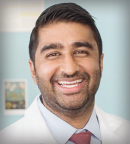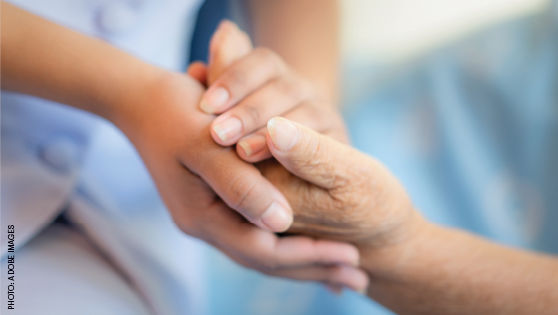
Sumit Shah, MD, MPH
The ASCO Post is pleased to reproduce installments of the Art of Oncology as published previously in the Journal of Clinical Oncology. These articles focus on the experience of suffering from cancer or of caring for people diagnosed with cancer, and they include narratives, topical essays, historical vignettes, poems, and photographic essays. To read more, visit jco.org and search “Art of Oncology.”
I first met Dianne during my 2-week stint as the attending physician in an academic oncology inpatient service. She was an elderly woman with snowy white hair, piercing blue eyes, and a razor-sharp wit that came out periodically when she was not too exhausted to speak. Just 6 months prior, she was diagnosed with metastatic lung cancer and had suffered from every complication imaginable—blood clots, bleeding, recurrent pleural effusions, trapped lung, and pneumonitis from the very immunotherapy she hoped would be her savior.
Dianne’s daughter, Susan, was a fixture at her bedside. A nurse for more than 30 years, she could not help but do what came naturally to her. Susan fiddled with her mother’s nasal cannula until it was more comfortable, she repositioned her IVs with Tegaderm so they would not restrict her movement, she playfully adjusted the Foley tubing until that ever-persistent air bubble displaced every drop of urine into the Foley bag, and she would pinch her mother’s skin to assess skin turgor. Here was a daughter caring for her mother as only a nurse would know how.
Both Parents Under Care
As I entered the room to greet them, Susan lowered her mask revealing a look of exasperation as if she were coming off a 12-hour shift. She explained to me that her father and Dianne’s husband, Jim, was also in the hospital on the heart failure service awaiting a cardiac device—his life supported by a single dobutamine drip to keep his frail heart pumping. Married for more than 50 years, Jim and Dianne, once high school sweethearts, were inseparable, with this hospitalization being the longest they had ever been apart.
Susan’s brother, Mark, was by their father’s bedside, and the two siblings would exchange notes after their respective physician teams rounded perhaps harkening back to their younger days communicating over walkie-talkies. Any news of progress for one parent would be tempered by a setback with the other—and so it went for the next several days.
“Perhaps the will to live or deciding to let go is more powerful than the steroids, diuretic drips, inotropes, transfusions, antibiotics, or even cancer therapies we administer.”— SUMIT SHAH, MD, MPH
Tweet this quote
It soon became apparent that Dianne was becoming more ill—her work of breathing had increased, the sensation of air hunger frightened her too much even to sleep at night, and she became less engaged on morning rounds. When we approached Susan and Mark about convening a family meeting to discuss their mother’s goals of care, they relayed that Dianne would not be able to make a decision without her most trusted confidante, her husband Jim, by her side.
In what felt like a tiny miracle in a hospital begrudgingly regulated by COVID-19 protocols and visitor restrictions in the peak of the pandemic, we arranged for Jim to be wheeled over from the other side of the hospital to Dianne’s room. Mark positioned his father’s wheelchair by his mother’s bedside. There, husband and wife, in matching hospital gowns, embraced for the first time in weeks—each more concerned about the well-being of the other. It was an unusual and bittersweet reunion of sorts—raw and beautiful. Jim leaned over in a seated position to stretch out his feeble and ecchymotic arms, a by-product of older age and years of a blood thinner, as he cupped Dianne’s hands with his own. He would not let go.
We explained to Dianne that her body was showing signs it was getting weaker, and we worried that time may be limited—perhaps several weeks to months, but it was difficult to prognosticate. We continued to say that in the event her heart were to stop or she were to stop breathing, it would be a sign that her body was shutting down from the cancer and resuscitation would only be futile. We recommended focusing on comfort.

Dianne initially looked to her family for guidance. Although Susan and Mark wanted to give their mother more time to contemplate, Jim felt strongly that a decision had to be made in the moment. “You never know what could happen,” he said. Dianne decided that she had been through enough—she just wanted to be comfortable in the confines of her own home. Jim shook his head in agreement. And so, we placed a do-not-resuscitate order in her chart. Jim’s eyes welled, but he maintained a strong grip, as much as his weakened ventricle would allow. Dianne was comforted knowing that her soulmate supported her decision and refocused her attention on the procedure he was to have the next day.
An Unexpected Passing
As I walked into the team room the next morning, I was greeted by a forlorn look on the resident’s face: “Mrs R’s husband had a v-fib arrest last night and passed away.” Even as a medical oncologist who confronts mortality daily, I was shocked. I had witnessed one of the most beautiful moments I had seen in medicine just several hours earlier only to now learn of Jim’s abrupt passing.
I rushed to Dianne’s bedside to offer my condolences. She was surrounded by her children who were doing their best to replace their father’s warm embrace. Dianne was sitting upright in bed aghast—her widened eyes fixated on the wall in front of her, her mouth gaped open—she was stunned upon hearing the news. Her work of breathing had only increased, and soon she was taking in large gulps of air as if the room were slowly being submerged under water.
A few hours later, my resident called me: “Mrs R just died.”
Lifelong Partners
As physicians, we often think our treatments and basic physiology are what keep our patients alive. However, what happened to Jim and Dianne—lifelong partners dying within hours of each other—puts that into question for me. Perhaps the will to live or deciding to let go is more powerful than the steroids, diuretic drips, inotropes, transfusions, antibiotics, or even cancer therapies we administer. It would appear that sometimes, despite our best interventions, the human body and the human mind are capable of knowing when to shut down. This only makes our ability to prognosticate toward the end of life that much more difficult.
It is impossible to know how much of an impact Dianne and Jim’s reunion had on their eventual outcomes. Perhaps Jim came to peace after our discussion with the fact that Dianne would no longer be suffering soon. Perhaps Dianne decided that life without her beloved husband would lose its meaning. Modern science will attempt to explain the pathophysiology of the broken heart—but the bond and deep connection that Jim and Dianne showed the evening before they both departed together is one that is more difficult to rationalize. And for that, I am grateful and humbled to have been a witness.
DISCLOSURE: Dr. Shah has received honoraria from Janssen; served as a consultant or advisor to Natera, Grand Rounds/Included Health; and received research funding from Genentech.
At the time this article was published in the Journal of Clinical Oncology, Dr. Shah was affiliated with the Division of Oncology at Stanford University, California.

